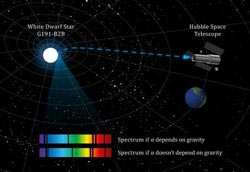White dwarf star throws light on possible variability of a constant of Nature

Researchers have studied a distant star where gravity is more than 30,000 times greater than on Earth to test the controversial theory that one of the constants of Nature -- the strength of the electromagnetic force, known as alpha -- is not a constant.<br><br>Credit: UNSW<br>
Dr Julian Berengut and his colleagues used the Hubble Space Telescope to measure the strength of the electromagnetic force – known as alpha – on a white dwarf star.
Their results, which do not contradict the variable constant theory, are to be published in the journal Physical Review Letters. Dr Berengut, of the UNSW School of Physics, said the team's previous research on light from distant quasars suggests that alpha – known as the fine-structure constant – may vary across the universe.
“This idea that the laws of physics are different in different places in the cosmos is a huge claim, and needs to be backed up with solid evidence,” he says.
“A white dwarf star was chosen for our study because it has been predicted that exotic, scalar energy fields could significant alter alpha in places where gravity is very strong.”
“Scalar fields are forms of energy that often appear in theories of physics that seek to combine the Standard Model of particle physics with Einstein's general theory of relativity.”
“By measuring the value of alpha near the white dwarf and comparing it with its value here and now in the laboratory we can indirectly probe whether these alpha-changing scalar fields actually exist.”
White dwarfs are very dense stars near the ends of their lives. The researchers studied the light absorbed by nickel and iron ions in the atmosphere of a white dwarf called G191-B2B. The ions are kept above the surface by the star's strong radiation, despite the pull of its extremely strong gravitational field.
“This absorption spectrum allows us to determine the value of alpha with high accuracy. We found that any difference between the value of alpha in the strong gravitational field of the white dwarf and its value on Earth must be smaller than one part in ten thousand,” Dr Berengut says.
“This means any scalar fields present in the star's atmosphere must only weakly affect the electromagnetic force.” Dr Berengut said that more precise measurements of the iron and nickel ions on earth are needed to complement the high-precision astronomical data.
“Then we should be able to measure any change in alpha down to one part per million. That would help determine whether alpha is a true constant of Nature, or not.”
The team includes Professor Victor Flambaum, Professor John Webb and Andrew Ong from UNSW, Professor John Barrow from the University of Cambridge, Professor Martin Barstow and Simon Preval from the University of Leicester and Jay Holberg from the University of Arizona.
Media contacts:
Dr Julian Berengut: +61 (2) 9385 7637, mobile +61 (0) 423 115 365 jcb@phys.unsw.edu.au
Professor John Webb: +61 (0) 414 011176 jkw@phys.unsw.edu.au
Professor John Barrow: +44 (0) 1223 766 696 jdb34@hermes.cam.ac.uk
Professor Martin Barstow: +44 7766 233 362 mab@leicester.ac.uk
UNSW Science media: Deborah Smith, +61 (2) 9385 7307, +61 (0) 478 492 060
Media Contact
More Information:
http://www.unsw.edu.auAll latest news from the category: Physics and Astronomy
This area deals with the fundamental laws and building blocks of nature and how they interact, the properties and the behavior of matter, and research into space and time and their structures.
innovations-report provides in-depth reports and articles on subjects such as astrophysics, laser technologies, nuclear, quantum, particle and solid-state physics, nanotechnologies, planetary research and findings (Mars, Venus) and developments related to the Hubble Telescope.
Newest articles

A new look at the consequences of light pollution
GAME 2024 begins its experiments in eight countries. Can artificial light at night harm marine algae and impair their important functions for coastal ecosystems? This year’s project of the training…

Silicon Carbide Innovation Alliance to drive industrial-scale semiconductor work
Known for its ability to withstand extreme environments and high voltages, silicon carbide (SiC) is a semiconducting material made up of silicon and carbon atoms arranged into crystals that is…

New SPECT/CT technique shows impressive biomarker identification
…offers increased access for prostate cancer patients. A novel SPECT/CT acquisition method can accurately detect radiopharmaceutical biodistribution in a convenient manner for prostate cancer patients, opening the door for more…





















